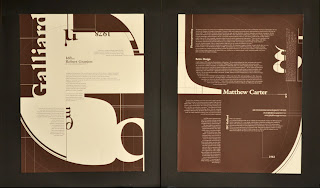Describe your app's intended audience and navigational concept.
My app is called Adepto. It's latin for, "to gather or collect". I thought this name was appropriate because I am gathering and collecting information on design for the viewer or subscriber. The intended audience is anyone who is interested in design or art and looking for inspiration.
The navigational concept or inspiration is based on "Plinko", which is the game from the Price is Right. I wanted the viewer to fall through the vertical space and encounter the concepts/content learned throughout the semester. I used the white space as a guide or path through the content. At the end of each section I made a conscious decision to make the art full bleed...to let the reader know that this was the end of this section. Then the swirlies/scribbles would pull you into the art within the circle and header for the next section. In addition to scrolling down the through the content, I made buttons out of the headers on the FC. Each button will take you to the appropriate content. I also created 2 violater callouts that link to my blog.
Explain the content structure(hierarchy and connectivity).
I created the hierarchy based on a couple of things. The first, I wanted the observations to be kind of a set up for the rest of the content the viewer would experience...kind of a sampling. That's how I thought of it through the semester. It was great to "see what's out there" before creating our own interpretation of the concept. This was a lead up to Projects...which takes the examples of other people's work and now show's implementation of ours.
The second reason, I wanted a kind of build up to the feature. That's why I made the first circle(observations) the smallest...it get's substantially bigger by the time you get to the feature. This was to identify it as the big bang. In an ideal world, I would have made the feature much longer and with more copy/content.
Also, the color hierarchy was based off of the Adepto logo. I used the sequence of colors within the logo to create the different section strokes and swirlies/scribbles. It was just an underlying visual link and framework. I also took that opportunity to use complimentary colors within each section.
Discuss the grid, rhythm and voice of the piece as we move throughout.
How did this change/evolve with the physical reinterpretation?
Grid- I used a four column grid. It worked really well and I ended up breaking it on the FC. It was funny as I was working on it, because I didn't think I would break it that quick. I used it as much as possible. Also, to make the Research and Feature sections a little different, I decided to use two columns for copy. For the observations and projects I tried to keep the copy to one column.
Rhythm- I wanted a type of dramatic build up to the feature. To do this, I created a little bit more open white space towards the top of the design. I wanted the FC to be really inviting and open and then create a build up to the feature. Content get's a little more intense towards the bottom(less white space).
Voice- I think the voice has a modern, artsy, design vibe to it. I've always really appreciated design that brings in the other visual arts, that's why I wanted the colorful swirlies and scribbles. I wanted something playful, fun and energetic. I also wanted the design to reflect how much I love and appreciate graphic design.
Discuss the inspiration behind the physical execution and the relationship between the virtual and physical pieces.
My inspiration for the physical piece was to make it playful and fun. I picked up on the angles that I used in the 2D piece and wanted to carry that into the 3D piece. I also wanted to bring the scribbles to life. I thought the yarn was playful and fun and would be a great tool to bring things to life. The shapes feel great in the hand and I wanted them to be interacted with in the physical piece. There is art on every angle and a new thing to explore with every turn. In addition to the angular pieces, I included two Dunnies(vinyl art toys) that relate to the Feature article on Blaine Fontana. They are a great example of bringing 2D to 3D and thought it would be great to integrate into the piece. Blaine Fontana is one of many fine artists that hook up with designer vinyl toy companies to create figures based on their art. Another one to check out is Joe Ledbetter...he's another favorite of mine and I have many of his toys.






















































